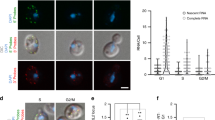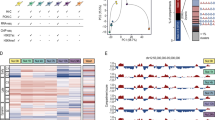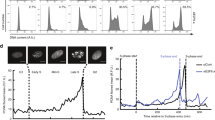Abstract
The transcription factor E2F-1 plays a pivotal role in the regulation of G1/S transition in higher eukaryotes cell cycle. We used a cell line containing an inducible E2F-1 and oligonucleotide microarray analysis to identify novel E2F target genes. We show that E2F-1 up-regulates the expression of a number of genes coding for components of the DNA replication machinery. Among them is the gene coding for the 32 Kd subunit of replication protein A (RPA2). Replication protein A is the most abundant single strand DNA binding complex and it is essential for DNA replication. We demonstrate that RPA2 is a novel E2F target gene whose expression can be directly regulated by E2F-1 via E2F binding sites in its promoter. In addition, expression of Topoisomerase IIα and subunit IV of DNA polymerase α is also up-regulated upon E2F-1 induction. Taken together, these results provide novel links between components of the DNA replication machinery and the cell growth regulatory pathway involving the Rb tumor suppressor and E2F.
This is a preview of subscription content, access via your institution
Access options
Subscribe to this journal
Receive 50 print issues and online access
$259.00 per year
only $5.18 per issue
Buy this article
- Purchase on Springer Link
- Instant access to full article PDF
Prices may be subject to local taxes which are calculated during checkout







Similar content being viewed by others
References
Bambara RA, Murante RS, Henricksen LA . 1997 J. Biol. Chem. 272: 4647–4650
Blattner C, Sparks A, Lane D . 1999 Mol. Cell. Biol. 19: 3704–3713
Brill SJ, Stillman B . 1991 Genes Dev. 5: 1589–1600
Din S, Brill SJ, Fairman MP, Stillman B . 1990 Genes Dev. 4: 968–977
Dyson N . 1998 Genes Dev. 12: 2245–2262
Erdile LF, Wold MS, Kelly TJ . 1990 J. Biol. Chem. 265: 3177–3182
Fairman MP, Stillman B . 1988 EMBO J. 7: 1211–1218
Fang F, Newport JW . 1993 J. Cell. Sci. 106: 983–994
Foiani M, Lucchini G, Plevani P . 1997 Trends Biochem. Sci. 22: 424–427
Georgaki A, Strack B, Podust V, Hubscher U . 1992 FEBS Lett. 308: 240–244
Hall M, Peters G . 1996 Adv. Cancer Res. 68: 67–108
Hasegawa T, Isobe K, Nakashima I, Shimokata K . 1993 Biochem. Biophys. Res. Commun. 195: 409–414
Hateboer G, Wobst A, Petersen BO, Le CL, Vigo E, Sardet C, Helin K . 1998 Mol. Cell. Biol. 18: 6679–6697
He Z, Henricksen LA, Wold MS, Ingles CJ . 1995 Nature 374: 566–569
Helin K . 1998 Curr. Opin. Genet. Dev. 8: 28–35
Hofferer M, Wirbelauer C, Humar B, Krek W . 1999 Nucleic Acids Res. 27: 491–495
Iftode C, Daniely Y, Borowiec JA . 1999 Crit. Rev. Biochem. Mol. Biol. 34: 141–180
Isaacs RJ, Davies SL, Sandri MI, Redwood C, Wells NJ, Hickson ID . 1998 Biochim. Biophys. Acta 1400: 121–137
Johnson DG, Cress W, Jakoi L, Nevins JR . 1994 Proc. Natl. Acad. Sci. USA 91: 12823–12827
Johnson DG, Schwarz JK, Cress WD, Nevins JR . 1993 Nature 365: 349–352
Kaelin WJ . 1999 Bioessays 21: 950–958
Kenny MK, Schlegel U, Furneaux H, Hurwitz J . 1990 J. Biol. Chem. 265: 7693–7700
Kowalik TF, DeGregori J, Schwarz JK, Nevins JR . 1995 J. Virol. 69: 2491–2500
Krek W, Livingston DM, Shirodkar S . 1993 Science 262: 1557–1560
Lam EW, Watson RJ . 1993 EMBO. J. 12: 2705–2713
Lee HH, Chiang WH, Chiang SH, Liu YC, Hwang J, Ng SY . 1995 Gene Expr. 4: 95–109
Leone G, DeGregori J, Yan Z, Jakoi L, Ishida S, Williams RS, Nevins JR . 1998 Gene Dev. 12: 2120–2130
Li L, Lu X, Peterson CA, Legerski RJ . 1995 Mol. Cell. Biol. 15: 5396–5402
Lindeman GJ, Gaubatz S, Livingston DM, Ginsberg D . 1997 Proc. Natl. Acad. Sci. USA 94: 5095–5100
Mossi R, Hubscher U . 1998 Eur. J. Biochem. 254: 209–216
Muller H, Helin K . 2000 Biochim. Biophys. Acta 1470: M1–M12
Nagelhus TA, Haug T, Singh KK, Keshav KF, Skorpen F, Otterlei M, Bharati S, Lindmo T, Benichou S, Benarous R, Krokan HE . 1997 J. Biol. Chem. 272: 6561–6566
Nishikawa NS, Izumi M, Uchida H, Yokoi M, Miyazawa H, Hanaoka F . 2000 Nucleic Acids Res. 28: 1525–1534
O'Connor DJ, Lu X . 1999 Oncogene 19: 2369–2376
Pearson BE, Nasheuer HP, Wang TS . 1991 Mol. Cell. Biol. 11: 2081–2095
Petersen BO, Lukas J, Sorensen CS, Bartek J, Helin K . 1999 EMBO J. 18: 396–410
Philipova D, Mullen JR, Maniar HS, Lu J, Gu C, Brill SJ . 1996 Genes Dev. 10: 2222–2233
Pierce AM, Fisher SM, Conti CJ, Johnson DG . 1998 Oncogene 16: 1267–1276
Qin XQ, Livingston DM, Kaelin WG, Adams P . 1994 Proc. Natl. Acad. Sci. USA 91: 10918–10922
Seroussi E, Lavi S . 1993 J. Biol. Chem. 268: 7147–7154
Shan B, Lee W-H . 1994 Mol. Cell. Biol. 14: 8166–8173
Sherr CJ . 1996 Science 274: 1672–1677
Spellman PT, Sherlock G, Zhang MQ, Iyer VR, Anders K, Eisen MB, Brown PO, Botstein D, Futcher B . 1998 Mol. Biol. Cell. 9: 3273–3297
Tanaka T, Nasmyth K . 1998 EMBO J. 17: 5182–5191
Treuner K, Ramsperger U, Knippers R . 1996 J. Mol. Biol. 259: 104–112
Vigo E, Muller H, Prosperini E, Hateboer G, Cartwright P, Moroni MC, Helin K . 1999 Mol. Cell. Biol. 19: 6379–6395
Weinberg RA . 1995 Cell. 81: 323–330
Woessner RD, Mattern MR, Mirabelli CK, Johnson RK, Drake FH . 1991 Cell Growth Differ. 2: 209–214
Wold MS, Kelly T . 1988 Proc. Natl. Acad. Sci. USA 85: 2523–2527
Yan Z, DeGregori J, Shohet R, Leone G, Stillman B, Nevins JR, Williams RS . 1998 Proc. Natl. Acad. Sci. USA 95: 3603–3608
Zhao L, Chang LS . 1997 J. Biol. Chem. 272: 4869–4882
Acknowledgements
We thank Drs WG Kaelin Jr and PD Adams for cells lines and Dr D Givol for reagents and critical reading of the manuscript. We thank Dr Shirley Horn-Saban for excellent technical assistance with DNA microarray analysis. This work was supported in part by grants from the Israel cancer Association (ICA), Minerva Foundation (Germany), the Israel Cancer Research Fund (ICRF) and Yad Abraham Research Center for Diagnostics and Therapy. D Ginsburg is an incumbent of the Recanati Career Development chair of cancer research.
Author information
Authors and Affiliations
Rights and permissions
About this article
Cite this article
Kalma, Y., Marash, L., Lamed, Y. et al. Expression analysis using DNA microarrays demonstrates that E2F-1 up-regulates expression of DNA replication genes including replication protein A2. Oncogene 20, 1379–1387 (2001). https://doi.org/10.1038/sj.onc.1204230
Received:
Revised:
Accepted:
Issue Date:
DOI: https://doi.org/10.1038/sj.onc.1204230
Keywords
This article is cited by
-
Genomics Portals: integrative web-platform for mining genomics data
BMC Genomics (2010)
-
Differential gene expression profiling in human cholangiocarcinoma cells treated with Clonorchis sinensis excretory-secretory products
Parasitology Research (2009)
-
Regulatory subunits of PKA define an axis of cellular proliferation/differentiation in ovarian cancer cells
BMC Medical Genomics (2008)
-
Expression of thymidylate synthase in human cells is an early G1 event regulated by CDK4 and p16INK4A but not E2F
British Journal of Cancer (2007)
-
Novel link between E2F and p53: proapoptotic cofactors of p53 are transcriptionally upregulated by E2F
Cell Death & Differentiation (2005)



